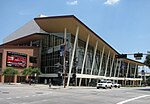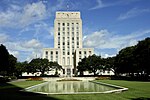Houston Music Hall
1937 establishments in TexasAlfred C. Finn buildingsBuildings and structures demolished in 1998Demolished buildings and structures in HoustonDemolished music venues in the United States ... and 3 more
Houston stubsMusic venue stubsMusic venues in Houston

Houston Music Hall was a 2,200-seat music venue located in Houston, Texas. The Music Hall opened in November 1937, at the same time as the Sam Houston Coliseum, which were built conjointly as the brainchild of Jesse H. Jones, and designed by Alfred C. Finn, his frequent collaborator. The project was financed by the Works Progress Administration at a cost of $1.3 million, and replaced Sam Houston Hall, which was a wooden structure that had been erected on the site for the 1928 Democratic National Convention and torn down in 1936.The hall was demolished in 1998. The former site of the building was redeveloped into the Hobby Center for the Performing Arts, which opened in 2003.
Excerpt from the Wikipedia article Houston Music Hall (License: CC BY-SA 3.0, Authors, Images).Houston Music Hall
Rusk Street, Houston
Geographical coordinates (GPS) Address Nearby Places Show on map
Geographical coordinates (GPS)
| Latitude | Longitude |
|---|---|
| N 29.761453 ° | E -95.369546 ° |
Address
Hobby Center for the Performing Arts
Rusk Street
77003 Houston
United States
Open on Google Maps








